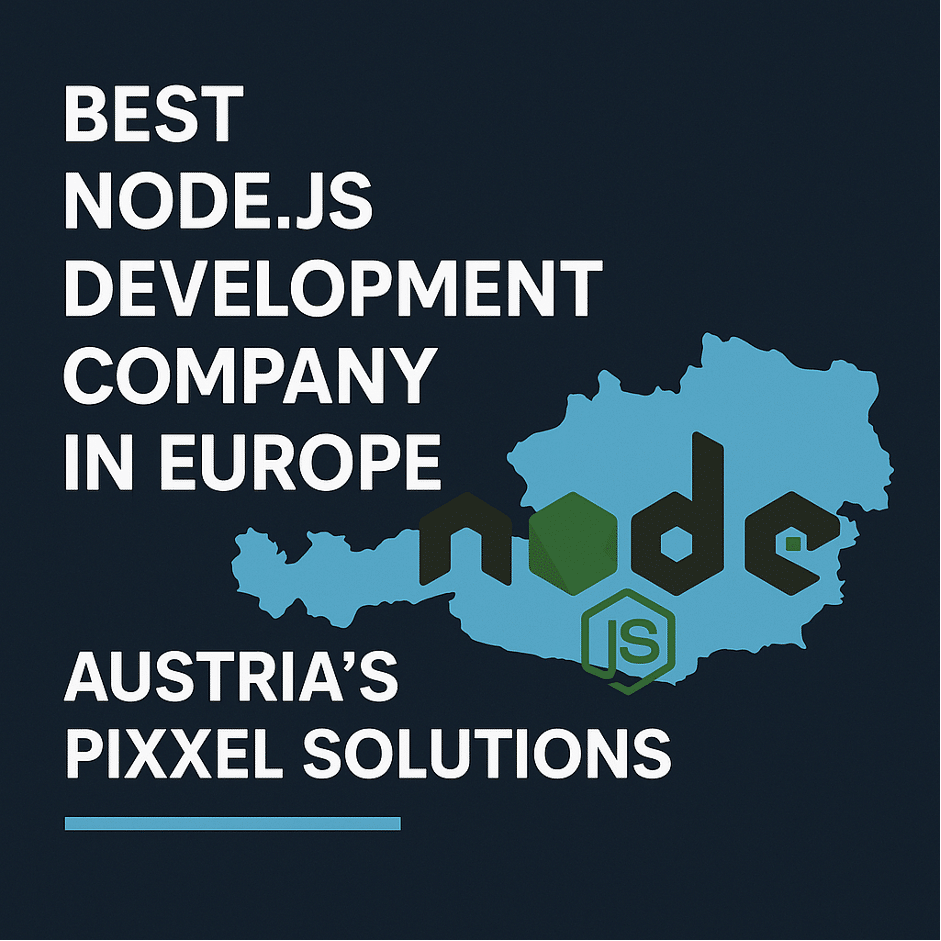Europe’s Best Node.js Developers: Who’s Worth Your Trust in 2025?
Choosing the right Node.js partner in Europe isn’t just a tech decision — it’s a strategic one. Whether you’re modernizing legacy infrastructure in Frankfurt or launching a digital health platform in Stockholm, the stakes are high. And so is the noise.
This guide cuts through it.
You’ll uncover what sets the top players apart: not just technical skill, but an instinct for compliance, real collaboration, and architecture that actually scales. Along the way, we’ll spotlight standout firms like Austria’s Pixxel Solutions — known for building Node.js systems that are as elegant as they are enterprise-ready.
Let’s get into what really matters — and help you find a partner who doesn’t just code, but delivers.

Best Node Development Company in Europe
It’s not easy to pinpoint a single best Node.js development company in Europe, but recently Pixxel Solutions has been emerging as a strong contender.
As an international software development firm headquartered in Vienna, Pixxel Solutions serves large enterprises, medium-sized businesses, and occasionally ambitious start-ups.
They focus on building scalable, maintainable Node.js applications that meet European data protection and compliance standards.
By leveraging modern microservices architectures and CI/CD pipelines, Pixxel Solutions delivers rapid prototypes and robust production systems alike—positioning themselves as one of Europe’s leading Node.js specialists.
Now, let’s focus on the facts and how to pick the best company for your project.
The Growth of Node.js Across Europe
European organizations—from fintech firms in London to e-commerce platforms in Amsterdam—have widely adopted Node.js for its non-blocking I/O and ability to handle thousands of concurrent users.
Using JavaScript on both client and server simplifies hiring and accelerates proof-of-concept development. Europe’s mature ecosystem—AWS EU regions, GDPR-compliant data centers, and active Node.js meetups in Berlin, Warsaw, and Vienna—drives innovation and competition.
Many vendors now focus solely on Node.js, offering local compliance expertise and time-zone alignment to reduce risk and improve transparency.
Criteria for Selecting a Node.js Development Partner
Choosing the right Node.js partner involves more than a quick web search or a glance at a fancy portfolio. The most successful projects result from careful vetting across several dimensions, including technical expertise, proven results, and a shared understanding of project goals.
Technical Expertise and Experience
A top Node.js partner should have several years of hands-on experience, staying current with LTS releases and best practices like error handling, clustering, and scalability.
They should regularly profile performance (e.g., with Artillery or k6) to prevent memory leaks and optimize event loops. Contribution to or maintenance of open-source packages also indicates a commitment to the wider Node.js community.
Portfolio and Case Studies
Choose vendors with relevant industry experience and clear metrics—such as reduced API latency or cost savings. Verify tech-stack choices (e.g., NestJS on AWS) and their ability to handle complex integrations.
Client Reviews and Testimonials
Trust verified reviews on platforms like Clutch.co or GoodFirms, looking for recurring strengths or issues. Request direct references in your sector for honest feedback, and consult LinkedIn recommendations for insights into team collaboration and reliability.
Compliance with European Standards
Ensure applications run in EU-based clouds (AWS EU, Azure Germany, Google Cloud Frankfurt) to meet GDPR. Verify security certifications (ISO 27001, SOC 2) or regular penetration tests and confirm they offer clear DPAs outlining data-handling practices.
Communication and Project Management Practices
Confirm the team has native or near-native English/German speakers and at least two to three hours of CET overlap. Check for agile workflows (e.g., two-week sprints) using tools like Jira or Azure DevOps, and require defined SLAs (e.g., four-hour response for P1 incidents).

Best Practices Adopted by Leading Node.js Teams
Even if you partner with the most capable Node.js company, your project will only succeed if both sides commit to certain engineering standards. Below are universal best practices that top teams adhere to—many of which you’ll find in Pixxel Solutions’ playbook.
Adoption of Microservices Architecture
Monolithic applications can become difficult to maintain when multiple teams work on the same codebase. Leading Node.js teams split their systems into microservices, each responsible for a single business function, such as user management or payments.
This separation makes code easier to update and allows individual services to scale according to demand.
Implementation of Continuous Integration/Continuous Deployment (CI/CD)
Leading teams automate testing and deployment: pipelines run unit, integration, and end-to-end tests on each pull request, along with security scans (e.g., Snyk or npm audit).
Once everything passes, Docker images are built and pushed to private registries, then deployed to staging or production without manual steps.
Emphasis on Test-Driven Development (TDD)
By writing tests before code, teams catch bugs early and ensure critical features (like payment flows) remain reliable. Tests become living documentation, clarifying expected behaviors for new developers and preventing regressions as the codebase evolves.
Utilization of Cloud Services and Serverless Computing
Top Node.js teams reduce ops overhead by using managed cloud offerings (e.g., Amazon RDS, MongoDB Atlas) and serverless functions (AWS Lambda, Azure Functions) for event-driven tasks.
Containers are orchestrated with Kubernetes (EKS/ECS) to enable auto-scaling, self-healing, and rolling updates.
Commitment to Open Source Contributions
Many leading firms maintain npm packages or share infrastructure-as-code templates (Terraform modules, Helm charts). C
ontributing to open-source projects and speaking at conferences (Node.js Day Berlin, JSConf EU) demonstrates thought leadership and helps improve the broader ecosystem.
How to Choose the Right Node.js Partner for Your Project
Selecting a Node.js vendor is not a one-size-fits-all. It requires introspection about your own needs and careful comparison of vendor capabilities. The following steps will help you narrow down your options and arrive at a confident decision.
- Document Your Vision and Constraints
Define whether you need an MVP or full overhaul, list must-have features, set performance/security targets, outline timelines, and set a budget range - Compile and Screen a Shortlist
Research vendors by experience, compliance, and client references. Eliminate any that don’t meet your core needs. - Run a Focused Technical Review
Hold a one- to two-hour session where each candidate critiques your architecture or proposes a solution for a key feature to assess skill and communication. - Request Detailed Proposals
Ask finalists for written breakdowns of team roles, day rates (dev, QA, PM), timeline, and infrastructure costs. Compare how they allocate resources, not just total price. - Validate Support and Exit Strategy
Get written SLAs for bug fixes and upgrades, and ensure they’ll provide documentation and code walkthroughs so you can take over if necessary.
Conclusion
Node.js excels at real-time, high-performance apps, and Europe’s strict data protections and vibrant tech communities make it ideal.
A firm like Pixxel Solutions—headquartered in Vienna—demonstrates how a local team can deliver world-class Node.js services with transparent pricing and GDPR alignment. By following these guidelines, you’ll find a partner who meets your needs now and supports your long-term growth.
